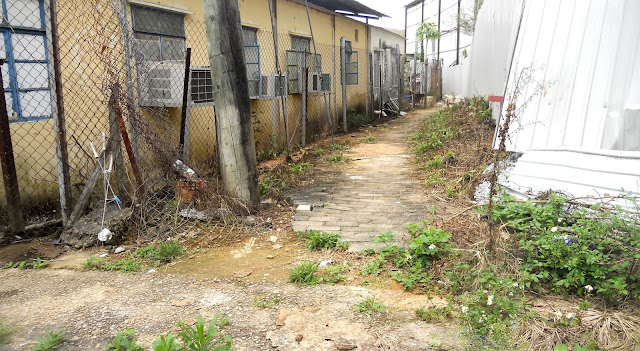The frontier road, as defined above, starts at the turn-off to the village of Liu Pok and ends at the red circle in the bottom, left-hand corner of the map. The green circle marks the position of a ‘police operational base’, the only practical consequence of which is that approximately half of the traffic west of the base is police vehicles.
The entire road when we first came this way was single-track, with occasional passing places:
Given how light the traffic still is, this has never been a problem. The occasional truck driver, heading to the fish ponds between the road and the border itself, is invariably considerate towards cyclists:
The truck is waiting in the entrance to the police operational base.
The road west of the base is much wider, so it is possible for smaller motor vehicles travelling in opposite directions to pass without either having to stop or slow down. However, a couple of years ago, the road was resurfaced, and a continuous concrete ‘kerb’ was constructed along the southern edge. I don’t recall ever experiencing any disruption, so it’s likely that a lot of this work was carried out while I was in the UK over the summer.
This is what the descent from the entrance to the police base looked like last year:
In case you’re wondering why I’m so far over to the right in the second image, it’s so that I can see whether anything is coming in the opposite direction.
The next still, from a video that I shot last winter, is exhibit #1 in the mystery that I’m about to describe:
At the time, the only road markings were a continuous white line along both sides of the road and the admonition ‘SLOW’ (in English and Chinese) where someone in authority had decided that such advice was necessary. Incidentally, I estimate that the average distance between such warnings on this road is less than 30 metres!
Now look at a recent photo of the same position:
A short section of the concrete kerb has been removed, and the road has been widened slightly. Some lines have been painted on the road itself.
And this is the mystery. As a former British colony, Hong Kong continues to follow British traffic regulations and road signs. However, I’ve never seen anything like this anywhere in Britain, so I can offer only conjecture as to its intended meaning. This is what it looks like if you’re heading east:
…while this is another view of what it looks like if you’re driving west:
It seems to me that traffic going east is expected to give way to traffic coming towards it. But why would it, given that the road is wide enough for both vehicles anyway? And why not use conventional give-way markings if that is the intention?
You probably won’t want to hear my answer to this conundrum, especially if you’re a local cyclist who often comes this way. The widening of the westbound ‘lane’ implies an expectation that wider vehicles will be using this road in the future. And work started recently on the construction of a ‘science park’—a joint venture between Hong Kong and Shenzhen—in the so-called ‘Lok Ma Chau loop’, an incised meander in the local river. There is now a constant stream of eight-wheel tipper trucks along Ha Wan Tsuen East Road, bringing in materials, which means that Paula and I no longer cycle that way because these behemoths take up the entire road.
A few weeks ago, I was forced off the main frontier road by these big trucks twice within a few days, at the locations shown in the following video stills:
Both locations are east of the police operational base, where the road is much narrower. In the first image, I was cycling in the direction of the video, and I realized immediately that I had to get out of the way. At the second location, I was travelling towards the camera, but the result was the same.
I don’t know for certain what these trucks are transporting, but it does seem likely that they are bringing in materials, such as sand and gravel, for use on the construction site rather than taking away unwanted material such as soil. This isn’t necessarily important, but the key point to make is that the trucks that forced me off the road could have reached the construction site by following the main roads. Most obviously do, given the sheer number entering and leaving the construction site, but if the long-term plan is to allow trucks to use the frontier road, which the recent alterations to this road suggest, then the frontier road becomes a no-go area for cyclists.
Fortunately, there are some grounds for optimism. My two encounters with big tipper trucks happened several weeks ago, and although I’ve been alert to the possibility that it might happen again, it hasn’t. I wonder whether police vehicles have stopped the drivers trying to use the frontier road as a rat run—common behaviour in Hong Kong—and told them to stick to the main roads. Unfortunately, the mysterious road markings suggest a different interpretation.






















































